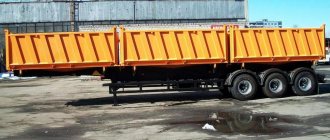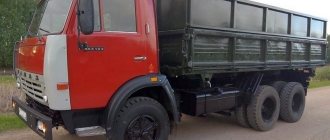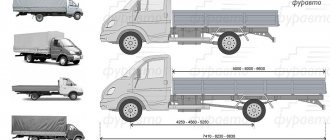Today, a special truck is usually used to transport goods. But it is important to note that such devices have some restrictions on the weight of the cargo that can be placed in them.
Dear readers! The article talks about typical ways to resolve legal issues, but each case is individual. If you want to find out how to solve your particular problem , contact a consultant:
+7 (499) 938-81-90 (Moscow)
+7 (812) 467-32-77 (Saint Petersburg)
8 (800) 301-79-36 (Regions)
APPLICATIONS AND CALLS ARE ACCEPTED 24/7 and 7 days a week.
It's fast and FREE !
If a larger load is placed on the platform than is allowed by the design, a variety of troubles may arise - not only breakdown, but also fines from the traffic police.
Type of semi-trailer
The classification of a truck directly depends on the semi-trailer used. The hitch indicates the load being transported. What types of universal trucks are there:
- Onboard. Platform without a roof. The sides are of a folding or removable type. Thanks to the crane, cargo is loaded and unloaded from the truck. This type of tractor is used to transport cargo for which there are no special requirements. These can be building materials, metal structures, etc. If necessary, an awning is attached to the sides.
- With awning (Eurotrucks). Platform with a steel frame with a thick PVC or tarpaulin awning. If necessary, the awning can be removed, installed or moved.
- Curtains. Type of tilt semi-trailers. The awning has 3 parts: 2 side and ceiling. Thanks to this solution, loading and unloading cargo is greatly simplified. Portal gates are also provided.
- Curtain-sided. They combine the structural elements of curtain-side and side-type semi-trailers. The awning can be fixed either at the base or at the outer parts of the side.
Truck classification and overall dimensions
To transport cargo of different volumes and weights, special trucks with trailers are provided, differing from each other not only in overall dimensions, but also in other parameters.
The useful volume and capacity of the trailer depend on the dimensions. Based on their composition, vehicles are divided into road trains or single models. Based on their design features, they distinguish onboard vehicles, specialized equipment (container carriers, dump trucks, etc.) and tanks.
Let's look at the main types of body trailers that you can buy now.
Curtainsider semi-trailer (Eurotruck)
This is a popular option, since loading and unloading can be done from either side, as well as from above, thanks to the presence of a removable awning. Regarding the question of how much the cargo weighs, the carrying capacity is from 20 to 25 tons, it can accommodate up to 33 Euro pallets, the total volume varies from 60 to 92 cubic meters. meters.
Dimensions:
- length 13 m 60 cm;
- width 2 m 45 cm;
- height 2 m 70 cm.
Rigid van semi-trailers
The second most popular option is loading and unloading only from the rear (the roof is in the way on top, there are blank walls on the sides). Has the following dimensions:
- length from 9 m 84 cm to 13 m 60 cm;
- width from 2 m 42 to 2 m 45 mm;
- height 2 m 70 cm (plus from ground to floor).
Body volume varies from 55 to 90 cubic meters. m.
Isothermal van or thermos
Food trucks are equipped with a layer of thermal insulation from floor to ceiling to maintain the same temperature for a long time. The carrying capacity of trucks with a thermos can range from three to 25 tons with a volume of up to 92 cubic meters. meters.
One of the varieties: a refrigerator, also known as a refrigerator with special equipment. Maintaining a special temperature regime (from +10 to -20 degrees) increases the cost of such cargo transportation.
By purpose
To transport goods that require certain conditions, special semi-trailers are used:
- Trawls. Heavy trucks used for the transportation of indivisible cargo, which are characterized by large dimensions and significant weight. Such trucks transport various machinery and equipment. Based on the modification, 2-10 axes can be provided.
- Container ships. They are used during the transportation of sea and rail containers. This type of freight transport is ideal for multimodal transport. Design features include a sliding frame.
- Refrigerators. They are used to transport cargo with a minimum shelf life and which require special temperature conditions. A refrigeration unit allows you to provide the required transportation conditions. It maintains the desired temperature inside the cargo compartment. Sandwich panels are used to make the body. Polystyrene foam is used as internal filler.
- Isothermal. The sides consist of multilayer panels. This is a simplified modification of refrigerators. The temperature inside the cargo compartment is maintained by reducing heat exchange with the external environment. This type of truck is designed for transporting chilled food products that do not require freezing.
- Tanks. You can choose between conventional and isothermal modifications, which provide heating and cooling installations. They are designed for transportation and storage of liquid cargo.
- Tipper. They have common structural parts with flatbed trucks. The main difference between dump trucks is the presence of a lifting mechanism. The tilt is carried out in the longitudinal or lateral direction. Loading of cargo is done from the rear or side. Dump trucks transport bulk cargo. Trucks with rock removal equipment are produced. Models with bottom unloading are convenient when transporting cement or grain.
- Jumbo. A semi-trailer with a non-standard design. the two parts have different dimensions.
In addition to the main types, there may be verticals and cassette-type semi-trailers for transporting reinforced concrete products, vehicles, animals, pipes, etc. For each type of cargo, a semi-trailer is selected that meets the transportation requirements.
How to load a truck without overloading the axles
It is important to remember that the category of the road also determines the issue of maximum axle load. At the moment, this factor also depends on the distance between the centers of the axes.
The main reason for this is that the smaller the distance between the centers of the axes, the greater the pressure on each square meter.
For 2022, permissible axial loads for biaxial loads are regulated by law and there is no need to calculate them.
At the same time, when loading a truck, you should remember the need to meet the following criteria:
| Distance between individual axles in meters | Permissible maximum axle load in tons | |
| For trucks of group “A” | For trucks of group “B” | |
| More than 2 | 10 | 6 |
| From 1.65 to 2 | 9 | 5.7 |
| From 1.35 to 1.65 | 8 | 5.5 |
| From 1.00 to 1.35 | 7 | 5 |
| Less than 1.0 | 6 | 4.5 |
The loading process itself, in order to avoid overload, must be carried out with constant control along the axes. It is understood that this process will have to be carried out on special scales.
This is the only accurate way to load with minimal errors in weight on each axle.
Today, the process of registering the loading of a truck can be carried out in different ways. At the same time, it is best to familiarize yourself with all of them in advance.
Otherwise, if there is overload, certain complications may arise - breakdown of the truck itself, as well as the imposition of significant fines (especially significant for legal entities).
How many weighing attempts are there when the axle is overloaded, the article says: a fine according to the law for overloading the axle. See the page for the fine for overloading passengers to individuals.
Find out the amount of the fine for overloading a car for individuals from this information.
Features of Eurotrucks
The truck is a truck tractor equipped with a curtain-sided semi-trailer or curtainsider. Eurotrucks come in the following types:
- Awning/curtain;
- Refrigerated;
- Isometric;
- Platforms.
Trucks have mandatory requirements regarding dimensions and the ability to seal the cargo being transported. Transportation of goods can be carried out within the territory of Russia and beyond its borders. The demand for Eurotrucks is associated with rapid loading and unloading operations and the ability to deliver goods in places where there is an asphalt road. Strong fixation of the awning to the frame makes it possible to provide high tension, which has a positive effect on windage and fuel consumption. Protection against theft of the contents of the luggage compartment is guaranteed by an awning with reinforcing mesh. In case of mechanical deformation of the material, it is easy to replace it with a new one.
Dimensions of tent truck 20 tons
Euro truck 20 tons is the most popular and is equipped with a tilt semi-trailer. The length of the truck is 13.6 m. The width and height reaches 2.45 m. Based on the characteristics of the cargo, the dimensions of the semi-trailer may vary slightly. The volume of the luggage compartment is in the range of 82-100 m³. The volume of internal space depends on the height of the semi-trailer.
Overall dimensions, namely the length of the tractor, are determined at the legislative level. In Russia, it is allowed to operate a road train up to 20 m long. The length limit for European countries is 16.5 m.
Weight
The type of tractor and semi-trailer affects the total weight of the truck. A standard semi-trailer with an awning weighs 6-7 tons. The refrigerator weighs approximately 9 tons and you need to add the weight of the tractor about 7 tons.
It is imperative to take into account the weight of the truck, since the maximum load depends on this parameter. The less a semi-trailer weighs, the more cargo it can load.
Load capacity
The load capacity of the tractor is determined depending on the axle load standards, based on the category of the road.
| Number of axles (tractor) | Number of axles (semi-trailer) | Gross truck weight, t | Maximum cargo weight, t |
| 2 | 2 | 36 | 22 |
| 2 | 3 | 38 | 24 |
| 3 | 2 | 37 | 23 |
| 3 | 3 | 38 | 24 |
When loading a truck, it is important to correctly distribute the load, taking into account the load on each axle.
How many pallets can a standard truck hold?
To make it convenient to store and transport the cargo, it is placed on pallets. They are platforms made of wood or plastic. As a rule, a semi-trailer can accommodate 33 Euro pallets (Euro pallets measuring 120x80 cm).
Finnish pallets 120x100 cm and square pallets 120x120 cm will fit in the luggage compartment in the amount of 22 pieces.
Open platform
Length – 12.6 m
Width – 2.5 m
Loading capacity – 25 tons.
A semi-trailer characterized by an open platform. Designed for 20 and 40 foot containers. The container ship has a sliding trailer frame.
Thrall
Length – 11-20 m
Width – 2.5-3.7 m
Load capacity – up to 93 tons
Low bed platform with 1-8 axles. The load capacity indicator directly depends on the number of axles.
Open flatbed semi-trailer
Length – 13.6 m
Width – 2.45 m
Side height – 50-80 cm
Load capacity – 20-24 tons
An open flatbed trailer is used for transporting large cargo, for which there are no special requirements. If necessary, it can be equipped with bunks, which will allow you to transport long items.
Tank truck
Used for transporting bulk and liquid cargo. The tanker truck may have a different configuration. The internal part contains 1 or several sections. There is also a refrigeration unit. Loading capacity – 12-20 tons. Useful volume – up to 40 cubic meters. meters.
Dump truck
Self-unloading truck. A trailer or semi-trailer is provided. Ideal for transporting bulk and bulk cargo. Unloading occurs by tilting the body. There are modifications of trucks with rear, side and double-sided unloading. Loading capacity is within 40 tons.
Car transporter
Tractor with semi-trailer for transporting cars, mid-size trucks and oversized equipment. This is a two-tier platform. Capacity depends on the length of the semi-trailer and varies between 7-10 cars (B-class). Allowable length is 20 meters. Tonnage – 15-20 tons.
Grain truck
A truck with a high-volume body. Made in the form of a tank/hopper. Transportation of bulk cargo is carried out without the use of containers. Self-loading is provided. The contents are unloaded by opening the side sides. Load capacity – 15-25 tons. Useful volume – 45-60 m³.
How to calculate allowable weight
The axles of the semi-trailer receive the greatest load by weight - which often leads to premature wear of this component of the truck. As a result, it will be necessary to check the technical condition of bridges in advance.
The tractor will not always be able to transport the excess weight. It is important to take the most responsible approach to distributing the load along various axes.
A separate issue is load distribution for the road train. The load distribution in this case will be slightly different.
It is important to note that the transportation process in this case is carried out in a standard manner. But for each trailer, semi-trailer as part of a road train, calculations must be carried out separately.
The easiest way to understand it is with a simple example:
- It is necessary to load cargo marked “DDD”.
- It is a pallet measuring 1,000 × 1,200 mm.
- Its mass is 1,229 kg.
- The loading process itself should be carried out only in 1 layer; nothing else should be placed on top.
- For transportation, a standard Eurotruck is used, its carrying capacity is 22 tons.
For transportation, a Mercedes Actros 1841 was chosen, as well as a Fliegl SDS 350 trailer. The load capacity will be 22 tons. In the case under consideration, the load should be distributed as follows:
There are a large number of specialized programs that are used to perform calculations in this way. Only in this way will it be possible to carry out the calculation without much difficulty.
And do this as quickly as possible, with minimal time. But it is worth noting that most of this software is paid.
At the same time, the presence of such programs will make the calculation easy and as simple as possible.











